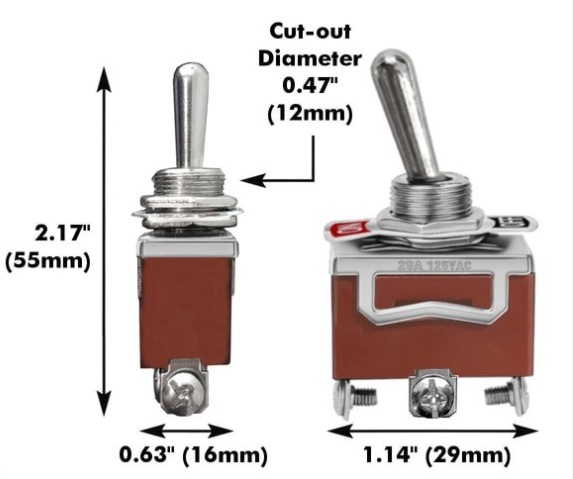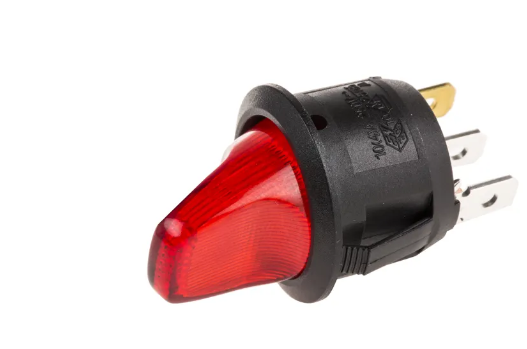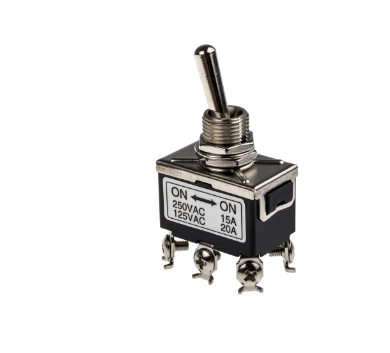

Electronic switches, such as toggle switches, are among the most fundamental and frequently utilized electrical parts. By stopping or resuming the flow of current, electronic switches enable on-off control for electrical circuits. This is accomplished by either disconnecting a metal contact from the terminal, which is the circuit’s endpoint, or reconnecting the two.
The associated device will turn on and function when the contact is connected, indicating that the circuit is closed and live and that electrical current can pass through. The gadget is then turned off when the contact is pulled away once more, breaking the current flow and opening the circuit.
A manually operated toggle, also known as a handle, lever, or hinge, is what allows toggle switches to be adjusted from one position to another. It usually latches into place in each position and stays there until it is moved back.
Actuators, or toggle switches, are what turn a machine on or off. They work similarly to rocker switches, although the latter are frequently categorized as a kind of rocker switch because of their see-saw-shaped button that swings between positions.
Joystick switches and toggle power switches are other names for toggle switches. They are adaptable tools that may be applied to nearly any electrical need.
Toggle Switch Applications
The toggle switch can be used for a wide range of tasks, from the straightforward (turning on or off a kettle gadget) to the intricate (managing several high-voltage circuits).
The light switch is the most well recognized design since it is so inconspicuous and essential to daily existence.
Additionally, toggle switches can be found in:
Industrial, commercial, and residential power outlets
systems for air cooling
Numerous kinds of electrical and industrial machinery, such as RCDs (residual current devices) and conveyor belts
Control panels on airplanes
Automobiles
Cars with toggle switches can easily access controls such as headlights and indication lights.
How Does a Toggle Switch Work?
Toggle switches come in a variety of designs and configurations, but their basic design is as follows. When this is pulled, an armature—a component that conducts electrical current—attached to the toggle moves, adding or deleting an electrical contact, thereby activating or deactivating the circuit.
Unless manually moved again, the switch will often stay in place. However, momentary switches also have an associated spring that, when released, will draw the actuator back to its initial position.
Toggle Switch Types
Toggle switches are a fundamental electronic component that come in a variety of sizes and styles for use in various contexts.
Many conductive metals, including as brass, copper, and silver, are used to make the internal contact points; these metals are frequently coated with gold or nickel. Additionally, toggle switches come with varying maximum current ratings and contact resistances, or how sensitive they are to electrical current.
Let’s examine a few of the most popular toggle switch models:
On-On Toggle Switches

Two devices are managed by on-on switches, which activate one of the two in each position. Another name for them is changeover switches.
A different kind called the On-(On) switch combines a click position that is standard with a spring-loaded one that will snap back if it is not held in place.
On-Off Toggle Switches

The simplest toggle switch design offers straightforward, binary on/off power supply control. Normally, when you move an on-off toggle switch from one position to another, you can hear it click. An alternative name for them is positive on-off switches.
On-Off-On Toggle Switches

The on-on design is also available as on-off-on toggle switches. In the middle, they provide a third neutral off position. When the (on) off (on) switch is disengaged, both on positions will click back to the off position, which is the default resting state.
Momentary Toggle Switches

Momentary switches are those that have a spring installed in them, which, when released, clicks the toggle back into the off position. The majority of toggle switches have a temporary variation, which is denoted by brackets, such as (on)-off-(on).
The typical ratings for momentary toggle switches are 12V or 15A.
Other Toggle Switch Types
Toggle Switch with Cover
These switches have caps or coverings that have many uses. They can stop the switch from mistakenly being turned on, safeguard the internal lever mechanism’s tips, and click the switch off when it’s closed.
Flat Toggle Switch
The name “flat toggle switch” can apply to both toggle switches with a flat surface and switches housed in flat metal plates that can be mounted vertically or horizontally, such as on walls or the sides of machines.
LED Toggle Switch
LED toggle switches have an LED light-emitting diode (LED) that shows the switch’s status (i.e., on or off). The LED is usually located in the toggle’s tip.
Matching accessories come in a range.
Mini Toggle Switches
Snap action switches or microswitches are other names for these tiny toggle switches. They react to a slight push exerted and have a spring-loaded toggle that is sensitive. The current flow powers the spring, which forces the contacts into position.
Microswitches are inexpensive and commonly utilized in both home and industrial equipment. They are primarily made for lower currents and are frequently employed as sensors to determine a component’s position for safety purposes. They can be used, for instance, to make sure a door or hatch is closed before the power is turned on and to cause the current to stop when the door or latch is opened again.
Mini toggle switches are used in:
Microwave ovens
Elevators
Vending machines
Industrial anemometers and control circuits
Microswitches are typically fitted in complex configurations.
They are resistant to damage from electric surges or arcs.
Large Toggle Switches
The purpose of large toggle switches is to provide on/off control. They are utilized in places like airplane control panels, where visibility and convenience of access are essential. Some have two toggles that are coupled.
Contact Configuration
There are four fundamental toggle switch designs that are hidden beneath the surface complexity, each with a unique arrangement of poles and throws. Throws are the various settings that a switch can be in, such as on and off, whereas poles are the distinct power supply that each switch controls.
Single Pole Double Throw (SPDT)

A single pole double throw switch reverses the direction of voltage, enabling the activation or deactivation of two devices with a single current switch. Car engines and many other applications employ them.
These are sometimes referred to as toggle switches or two-way switches. An additional variant is the three-position or three-way switch, which allows two distinct positions to control a single device (like a light switch).
Single Pole Single Throw (SPST)

These are simple on-off switches that send a single incoming current into an open or closed circuit that serves a single device. This is the typical light switch design.
Double Pole Double Throw (DPDT)

Double throw, double pole In essence, switches are a pair of on/off switches that work together. They make it possible to adjust the voltage applied to a certain device. Reversing switches for electric motors are among the uses.
Switches that are either on or off are DPDT. Four-position or four-way switches are other names for them.
Double Pole, Single Throw (DPST)

Double pole single throw switches make it simple to operate two devices that are used in tandem by allowing the simultaneous turning on or off of two separate circuits.




